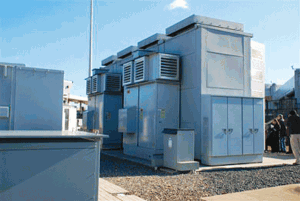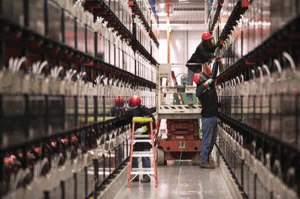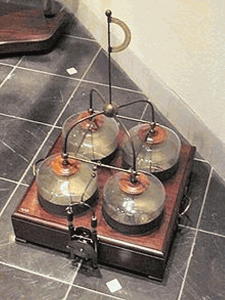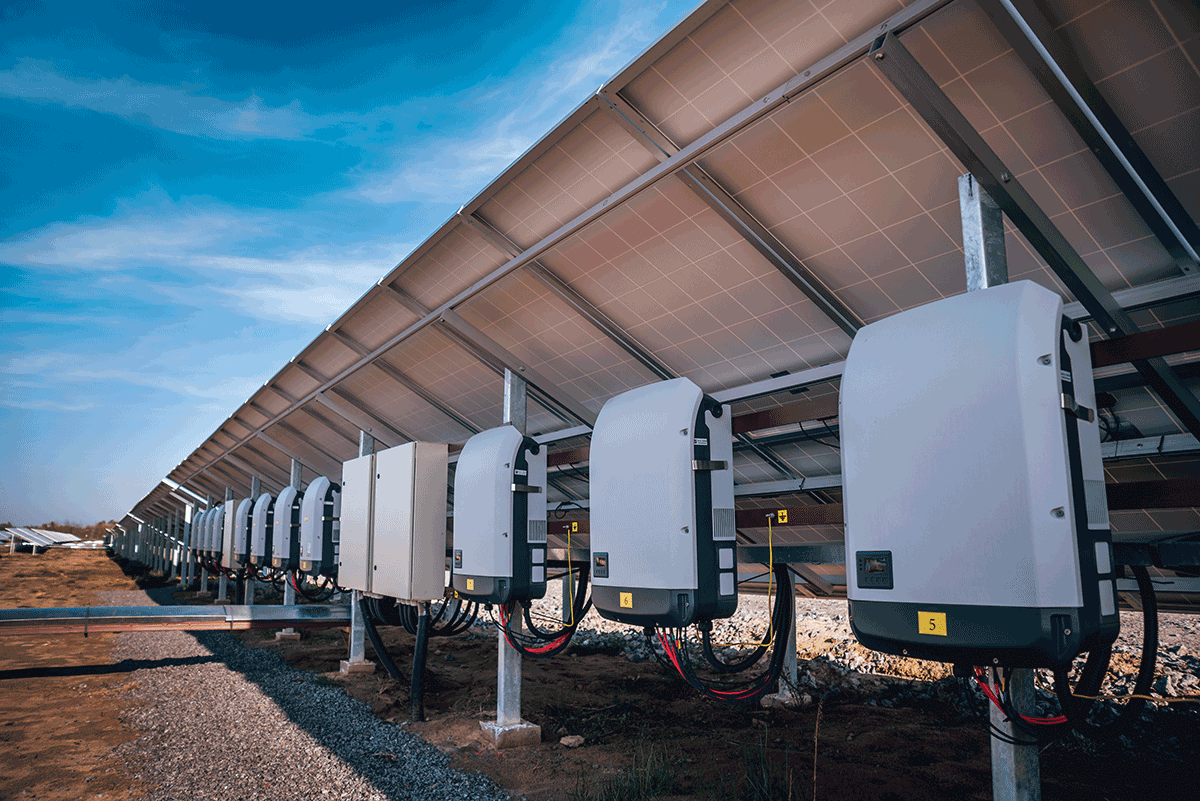
We continue to perfect the plans for the Smart Grid and to find more efficient ways to use and monitor our consumption of electricity, but how about those times when we need that little extra?
We have seen the effects of weather, heat, overuse, and population explosion on the current utility grid, and many scenarios have been planned for the sustainment of electricity generated for future use. To complement and stretch this generated power, we have discovered and continue to explore many ways to store this bounty of energy and electricity, and are now beginning to efficiently combine both generation and storage to create a symbiotic relationship that can allow us to not only have electricity today but in the future.

Photo 1. Not only can we generate but we can store energy to supply short-term demands and to lessen loads on the grid with the use of large scale batteries.
New technologies that are available have not only shown us how we can build better energy storage technology but how we can store massive amounts of energy. Can you imagine a battery so big that it can light up the city of Fairbanks, Alaska?
Bold Beginnings and New Challenges
Back in 2003, the world’s largest commercial use battery was plugged in to provide emergency power to Fairbanks, Alaska’s second largest city and one of the United States’ most isolated. The behemoth of its time, a roughly 2,000 square meter rechargeable battery — a bit bigger than your average car battery — and weighing in at 1,300 metric tons lives in silence at a warehouse near the city, always on the ready.
Although this bold project is located where temperatures plunge to -51 degrees Centigrade in winter, the life-sized battery will easily provide 40 MW of life-sustaining electricity for up to 7 to 12 minutes for about 12,000 people. While this doesn’t seem like much, it is precious time necessary to bring many diesel generators on line when a blackout occurs up in this frozen tundra, situated far from any type of emergency power.
The Technology
This earthquake-proof technology contains 13,760 NiCad cells, which are bigger than the versions of those used in many portable electronic appliances including laptop computers and radios [The Telegraph].
Not to be outdone, Duke Energy will, with this same type of technology, team up with Austin, Texas-based “Xtreme Power” to embark on providing the first common interconnection of America’s three power grids via a technology called “Powercell” energy storage. The “SuperStation,” as it is being dubbed, will be an energy market hub and balancing authority, helping to ensure the efficient and reliable flow of power from multiple renewable and conventional generation sources in all three power regions to customers across the U.S., Canada and Mexico [Sustainable business.com].

Photo 2. The technology, while much the same, has been greatly refined due to advances in battery materials and science.
With this type of technology in use and being proposed at even greater scale is there any doubt that we will one day be able to efficiently store electricity for use when necessary, but we could deliver it on demand when we want — with vast reserves to alleviate the current issues that we face with today’s aging grid system.
Let us look into the subject and see where we are and what’s on the horizon.
What Will We See?
In this article, the reader will see the humble beginnings of energy storage and, in particular, battery storage for the sustainment of electricity, and how energy storage has developed over time with innovative technology and good solid engineering principles to create what we now know to be many of the modern methodologies used for the storage of energy (electricity).
We will also see that while advances have been made towards this end, we still use many of the old tried and true technologies that we have always used, albeit in a much more efficient form and footprint.
We will then see how the NEC deals with energy storage and how the requirements need to be adhered to so that a safe installation and inspection can be ensured, producing a viable source of energy storage for years to come.
Back in the Day

Photo 3. Around 1936, in a village near Baghdad, archaeologists uncovered a set of terracotta jars, each containing a rolled-up sheet of copper which housed an iron rod. Some scientists speculate these to be ancient galvanic cells (roughly 2,000 years old, though the find’s age is still debated), and dubbed them the “Baghdad Batteries.” It is believed a common food acid, such as lemon juice or vinegar, served as an electrolyte. (Wikipedia)
When electricity was “the new kid on the block and all the rage,” no one ever thought about storing it. As a matter of fact, just getting it was all one could imagine, and that was only if you lived in the big city. This was a time when many new ideas sprouted up and the use of electricity was off and running. Transmission had been pretty much handled and new copper conductor was being hung from pole to pole across this great nation, spreading prosperity and invention via this new medium, called electricity.
Bottling Lightning
Remember when we were kids and the great thrill of the summer was to get a big sun-tea jar and try to catch lightning bugs? Sometimes you got a bunch and sometimes you got a couple, but, boy, was it a thrill when the sun went down to see the stored energy that these little wonders of nature could produce.
Well, not so long ago, even though the technology existed, thethoughtof storage much less theactof storing this resource never really dawned on the everyday user. Once the need and the desire to illuminate the darkness with a safer means than fire, lanterns, or candles came into play, all of a sudden the race to capture electricity was begun. While many ideas were looked at, the one constant was always the need for storage for long periods of time, for the reuse of the electricity that was being generated.
Unlike conventional generation, which is typically measured only in megawatts, large grid-tied energy storage systems have both power and energy ratings. It is vital to understand the difference between these units of measurement.
-
Poweris measured in kilowatts (kW) or megawatts (MW) and refers to the amount of electricity a storage system can absorb or supply at any given instant.
- Energy is measured in kilowatt-hours (kWh) or megawatt-hours (MWh) and refers to the total storage capacity of a system, or the length of time a battery can provide a set amount of power.
Most people consider passive storage types as a means of storing off-peak energy for delivery to the grid during on-peak periods; however, not all storage needs are the same, and neither are the storage solutions.

Photo 4. The Voltaic Pile, while once the great purveyor of electricity, helped lead the way and forever etched the term volt into the everyday landscape of the electrical industry. (Wikipedia)
The old philosophy of storing cheaper energy from nighttime generation for use during the higher-priced daytime periods is helpful, but today’s energy storage can accomplish much more. There is significant variation in performance characteristics and capabilities among competing energy storage technologies.
With a constant emphasis placed on batteries for transportation, some people question these technologies’ ability to scale to utility-significant power and energy capacities. However, hundreds of MW of energy storage systems, not including pumped hydro and compressed-air systems, are now currently in operation all over the world. Energy storage systems can provide a valuable solution to independent power producers, grid operators, transmission and distribution utility co- ops, as well as to commercial and industrial end users.
Before we jump into these mega systems that are being proposed as a long-term solution to our continued need for electricity, let’s look at some of the humble beginnings of energy storage. First, let’s start with some industry facts.
The Dawn of Invention
When we finally embarked on the mission of storing energy, the first means and methods were by today’s standards very crude, but this was new science then. One wonders what life would be like without the convenience of modern batteries, which are not only used to store massive amounts of energy but to power the steady pacemaker or to bring sound to an otherwise quiet world.
At the dawn of the discovery of electricity, battery storage was used in the distribution of direct-current electric power networks, and is appearing again. Battery systems connected to large solid-state converters have been used to stabilize power distribution networks and worked quite effectively, until methodologies changed and technology followed.
Volta, Leclanché, and Faure

Photo 5. The term battery was once used by Ben Franklin to describe a set of capacitors that were tied together to use for his experiments with electricity. These capacitors or Leyden jars were charged with a static generator and discharged by touching metal to their electrode. Linking them together in a “battery” produced a stronger discharge. (Wikipedia)
Who were some of the energy storage pioneers and what were their contributions? An early inventor/pioneer in electrical storage named Alessandro Volta received much credit for the modern battery; hence, the usage of the word “volt,” the name of the standard unit of electrical potential. Volta experimented with many different types of metal to induce voltage from many layers of conductive medium in a salt/zinc solution, until a desired voltage was realized. This resulted in the “voltaic pile” using what we now call galvanic action, as noted by Sir Humphrey Davy in 1813, to create electricity using several types of electrolyte mediums.
The word “galvanic” is credited to Luigi Galvani, who, prior to Volta, in 1746 noticed that he could make a frog’s legs twitch in response to touching two dissimilar metals, both in contact with moisture, and discharging the resultant electricity into the muscles of the frog’s legs. The galvanometer was also named after Mr. Galvani. This instrument is a moving coil set in a permanent magnetic field. Current flowing through the coil deflects it and an attached mirror reflects a beam of light. It was the first accurate electrical measuring instrument.
While the voltaic pile was indeed a breakthrough, it wasn’t very good at delivering currents for a long period. This need spurred a young man named John Frederic Daniell to create the Daniell cell, which produced roughly 1.1 volts. These cells were incorporated into our lives to power telegraphs, telephones, and to ring doorbells in homes for more than a century.
Following up these notables, were the lead acid battery in 1859 by Raymond Gaston Plantéand the Leclanché carbon-zinc battery in 1866, which was also noted as the first “dry cell” after a moist ammonium chloride paste was substituted for the liquid electrolyte and the battery was sealed. This type of battery could be used in various positions and moved about without spilling.
In 1881, Camille Faure’s “lead-acid battery suitable for autos” was introduced and was the foundation, if you will, of modern automobiles’ lead-acid battery. Finally, we have the Edison battery from 1898 to 1908, the nickel-cadmium battery from 1893 to 1909 and the famous alkaline-manganese battery.
The alkaline-manganese battery — or as we know it today, the alkaline battery — was developed in 1949 by Lew Urry at the Eveready Battery Company Laboratory in Parma, Ohio.
And in 1950, the zinc-mercuric oxide alkaline battery was developed by Samuel Ruben, an independent inventor, and was licensed to the P. R. Mallory Company, which later became Duracell, International. Mercury compounds have since been eliminated from batteries to protect the environment.

Photo 6. Smart Grid Storage Systems (SGSS) like this A123 nanophosphate system offer multi-megawatt energy storage that will allow utility generation to operate at peak capacity and will use battery storage to supply the system during times of need, to relieve the burden of the excess generation needed to keep up with the demand.
These devices, though primitive at the time, are the many pieces of the foundation of the super batteries that we are now incorporating into the grid for reliability, predictability, and storage of electricity.
Energy Storage via Battery and the NEC
Now that we have seen the task ahead and have visited the humble beginnings of the science that has turned metals and medium into a viable energy storage giant, let’s address installation and inspection of a super battery.
Let’s start with NEC 480. The definition of a battery system is “interconnected battery subsystems consisting of one or more storage batteries and battery chargers, and can include inverters, converters, and associated electrical equipment.”
Having looked at the types of energy storage batteries and the many mediums that are used, we notice in the NEC definition for nominal battery voltage that we do have some differences. The Informational Note lets us know that we could very well have batteries that can vary from 2 volts per cell, which is common for a lead- acid system, to 1.2 volts per cell from an alkali system, or even to as much as 4 volts per cell, with a Lithium-ion system.
Along with the medium used within the batteries themselves, we have what the NEC refers to as a sealed cell or a sealed battery which is “a cell or battery that has no provision for the routine addition of water or electrolyte or for external measurement of electrolyte specific gravity and might contain pressure relief venting.”
We also have what is termed storage battery, along with our NEC definitions of batteries, which is, “a battery comprised of one or more rechargeable cells of the lead-acid, nickel-cadmium, or other rechargeable electrochemical types.”
This latter type is generally what is being used in the super battery storage units that are in use currently and that are being deployed throughout the world. Many other new mediums are also being developed to refine and extend the amounts of energy capable of being stored and the storage capacity itself.
110.3(A),(B) Examination, Identification, Installation, and Use
When we are installing these systems, remember that the basic NEC requirements always come into play unless they are modified by Article 480. We still need to consider the installation requirements per the manufacturer as we are reminded of in NEC 110.3(B).
With many of the newer technologies, very important guidelines and instructions are given as to the installation, placement, orientation, and operation that in many cases, due to the nature of the installation, need to be followed to the letter.
110.26 Working Spaces
Working space requirements in 110.26 are also required, and we are reminded of the basic requirement in 480.9(C). In an energy storage system utilizing batteries, one should take note of exactly where the working space is measured from as well; and the working space in this type of application is measured from the edge of the battery rack again as indicated in 480.9(C).
Guarding of live parts is required for all battery type energy storage systems as indicated in 480.9(B) and needs to comply with the provisions in 110.27.
Wiring and Equipment for Battery Storage Systems
The wiring and the equipment for a battery type energy storage solution is required to follow all of the applicable NEC requirements for the same type of wiring and equipment operating at the same voltage unless permitted by 480.4.
Disconnecting Means for Battery Type Energy Storage
Another requirement that should never be overlooked is disconnecting methods for these systems. A disconnecting means is required by the 2011NECfor all ungrounded conductors in a stationary battery system that exceeds 50 volts. That same disconnecting means is also required to be readily accessible and located in sight of the battery system as indicated in 480.5.
While we are discussing means of disconnect, be sure to check out NEC 240.21(H) for information on the location of the overcurrent protection device for battery conductors.
When inspecting these systems, one needs to remember that this is a very large battery made from many small batteries either in series or parallel. Don’t be overwhelmed with the sheer size of it all.
Sizing It All Up
Let’s recap our journey through energy storage and reflect. We have seen the need for mega storage of energy and know that it cannot only be done, but is being implemented and is growing larger as the need for more storage is presented.
We have journeyed back into the history of the battery as an energy storage means and have seen many struggles yet advances that have helped shape the way we are currently using this technology for even greater good.
We have seen how the NEC addresses the idea of battery storage systems from the normal to the mega system, and that, as we progress, we are in lock step with the new technologies that are being produced.










Find Us on Socials